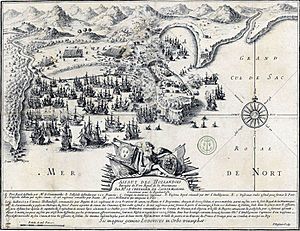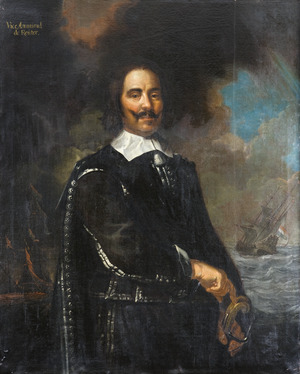Invasion of Martinique (1674) facts for kids
Quick facts for kids Invasion of Martinique |
|||||||
|---|---|---|---|---|---|---|---|
| Part of the Franco-Dutch War | |||||||
 A French lithograph of the invasion |
|||||||
|
|||||||
| Belligerents | |||||||
| Commanders and leaders | |||||||
| Strength | |||||||
| 1 frigate 1 merchant ship 160 men |
18 ships of the line 36 smaller ships 7,400 men |
||||||
| Casualties and losses | |||||||
| 6 killed 10 wounded |
461–1,300 killed or wounded | ||||||
The invasion of Martinique in 1674 was a big surprise! The Dutch Republic tried to take the island of Martinique from France. Even though the Dutch had many more ships and soldiers, the French won a huge and unexpected victory.
Contents
Why the Dutch Attacked Martinique
In 1672, France and England started a war against the Dutch Republic. This was called the Franco-Dutch War. The Dutch navy was very strong. They won battles in the North Sea. Because of this, England stopped fighting in early 1674.
Now, the Dutch could use all their naval power against France. They decided to attack Martinique. This island was the main base for France's colonies in the Caribbean Sea. The Dutch thought that if they captured Martinique, they could easily take other French colonies. They also wanted to rebuild their own damaged colonies and trade routes in the Caribbean. This would give them control over the Lesser Antilles islands.
The Dutch Invasion Force
To achieve their goal, the Dutch put together a very strong invasion fleet. It was led by Admiral Michiel de Ruyter. Many people thought he was the best naval commander of his time. He had already won battles against England.
His fleet included eighteen large warships called ships of the line. His own ship, the De Zeven Provinciën, had 80 cannons. There were also thirty-six smaller warships and many transport ships. In total, 7,400 soldiers were part of this force. A young leader, the Count of Styrum, was supposed to lead the ground troops. But the main attack was given to the Count of Hoorn. He was famous for planning attacks on forts.
Martinique's Defenses
Martinique was defended by local soldiers called a militia. They had about 2,000 men. However, the French commander, the Marquis de Baas, made a mistake. He thought the Dutch would attack Saint-Pierre in the north. So, he sent most of his forces there.
But Admiral de Ruyter chose to attack Fort-Royal on the west coast. This was the main harbor. The fort at Fort-Royal was called Fort Saint Louis. It had a local militia company. The French warship Les Jeux, a small frigate with 28 cannons, was also there. It was commanded by Captain Thomas-Claude Renart. Some merchant ships in the harbor also offered help.
The Fort-Royal militia only had about 100 men. A quarter of them quickly ran away. The fort itself was mostly wooden fences around a hill. It had a few cannons near the water. The strongest defense was the warship Les Jeux. It had 150 men.
The Battle for Fort-Royal

The Dutch fleet arrived near Martinique on July 19, 1674. But the weather was calm, so they could not attack that day. This gave the French time to prepare. They sank two merchant ships to block the main channel into the harbor. They also put a strong chain across the inner harbor entrance.
A brave adventurer named Guillaume d'Orange helped organize the remaining militia. Sailors from the sunken ships and some trained soldiers from Les Jeux joined them. On the morning of July 20, the island's governor, the Chevalier de Sainte-Marthe, arrived. He brought a few more militia members. Even with these additions, the French had only about 160 defenders.
First Dutch Attack
The Dutch attack started around 9 AM with cannon fire from their ships. Then, soldiers in small boats headed for the shore. They landed on a beach below the cliffs, not directly at the harbor. This was around 11 AM. The French defenders fired down from the fort, and the Count of Styrum was injured.
Some stories say that many Dutch soldiers started looting a warehouse full of rum after landing. But their commanders gathered them. They then prepared to attack the fort.
The Dutch tried to attack the fort's wooden fences from the land side. But the French militia and sailors fired their muskets and pushed them back. Another Dutch group found a narrow path up the cliffs. Guillaume d'Orange saw them. He couldn't use a musket because of old injuries, so he threw rocks down. Other soldiers and sailors quickly came to help. A naval officer, Ensign de Martignac, fired his gun many times into the crowded Dutch soldiers. The fighting became hand-to-hand combat. The Dutch flag-bearer was killed, and Captain Renart himself captured the Dutch flag.
The Dutch retreated in confusion.
Second Dutch Attack
In the afternoon, the Dutch attacked again. First, their frigates tried to enter the harbor directly. But the sunken ships blocked them. The French fort cannons fired at them from one side. From the other side, the Les Jeux and Saint-Eustache ships fired their cannons. The Dutch ships had to retreat.
Then, the Dutch soldiers attacked the fort again. But they faced terrible cannon fire. Captain Renart had moved Les Jeux close to the shore. It fired grapeshot (small metal balls) at the advancing Dutch lines. He also moved six of the ship's small cannons into the fort. These fired directly into the attacking Dutch soldiers.
After many hours of failed attacks, Admiral de Ruyter ordered a retreat. The Dutch lost between 1,000 and 1,300 soldiers, killed or wounded.
The French had only sixteen casualties in total. But they were low on ammunition. They thought the Dutch would attack again soon. So, Governor Sainte-Marthe ordered the fort to be left and the ships to be burned. The other merchant ships were set on fire. But Captain Renart decided to wait. He stayed on Les Jeux all night.
In the morning, he saw no sign of Dutch activity on the beach. He sent his first officer to check. The officer found that the Dutch had gone back to their ships during the night. Their fleet was already sailing away! They left behind only a few badly injured soldiers and abandoned weapons. The small French defense force had won an amazing and unexpected victory.
What Happened Next
French historians still talk about Martinique as an incredible military success. The famous de Ruyter and the powerful Dutch navy were defeated by just one small frigate. Martinique stayed a French colony.
Captain Renart was given a high noble title, Marquis d'Amblimont. He later returned to Fort-Royal as the governor-general of the French Caribbean.
The Dutch fleet, embarrassed, sailed back across the Atlantic. Many more of their men got sick on the journey. Their plans to expand their colonies in the Americas were stopped forever. They were left with only Surinam and the Dutch Antilles. Some modern historians of Dutch naval history don't even mention this battle.
Sources
- Charles Joseph Delahaut and Jean-Baptiste L'Écuy, Annales civiles et religieuses d'Yvois-Carinan et de Mouzon (Desoer and Delaunay: Paris, 1822).
- Alain Demerliac, La marine de Louis XIV. Nomenclature des vaisseaux du Roi-Soleil de 1661 à 1715 (Nice: Editions Omega, 1992).
- Léo Elisabeth, La Société martiniquaise aux XVIIe et XVIIIe siècles (Paris: Éditions Karthala 2003).
- David F. Marley, Wars of the Americas: A Chronology of Armed Conflict in the Western Hemisphere (2nd. ed., 2 vols., Santa Barbara, CA: ABC-CLIO, 2008).
- Abraham van der Moer, "Michiel Adriaenszoon de Ruyter: Ornament of His Age (1607–1676)", in The Great Admirals: Command at Sea, 1587–1945, ed. Jack Sweetman (Annapolis, MA: U.S. Naval Institute Press, 1997), pp. 82–111.
- James Pritchard, In Search of Empire: The French in the Americas, 1670–1730 (Cambridge: Cambridge University Press, 2004).
- Charles de la Ronciere, "L'attque du Fort-Royal de la Martinique par Ruyter (20 Juillet 1674)", Revue de l'histoire des colonies françaises, 7 (1919), pp. 35–46.
- Antonie Paul van Schilfgaarde, De Graven Van Limburg Stirum in Gelderland en de geschiedenis hunner bezittingen (3 vols., Assen: Van Gorcum, 1961).
- Michel Vergé-Francheschi, "Les gouvernerurs des colonies françaises au XVIIIe siècle. L'exemple antillais et canadie", in Les Européens et les espaces océaniques au XVIIIe siècle: actes du colloque de 1997, ed. François-Xavier Emmanuelli (Paris: Presses de l'université Paris Sorbonne, 1997), pp. 109–130.
Primary Sources
- Gerard Brandt, La vie de Michel de Ruyter, (Amsterdam: Blaeu, 1698).[1]
- Eugène Bruneau-Latouche, ed., "Les défenseurs de la Martinique lors de l'attaque de Ruyter", G.H.C. Bulletin No. 92 (April 1997), pp. 1928–1942. [2]

